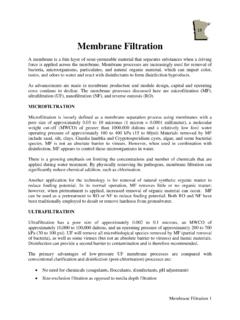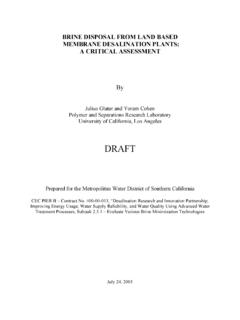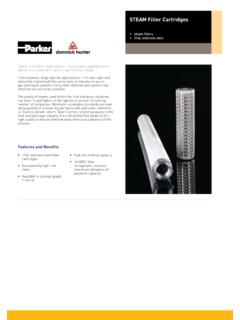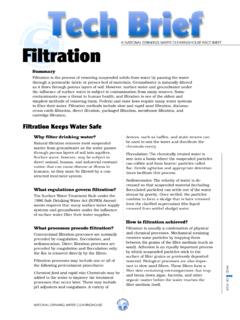Transcription of Desalination Guidelines Development for Drinking …
1 Rolling Revision of the WHO Guidelines for Drinking -Water Quality Draft for review and comments (Not for citation) Desalination Guidelines Development for Drinking Water: Background By Joseph A. Cotruvo World Health Organization August 2004 Introduction More than 11,000 Desalination plants are in operation throughout the world producing more than 20 million cubic meters (roughly six billion gallons) of water per day. About 63% of the capacity exists in West Asia and the Middle East. North America has about 11% and North Africa and Europe account for about 7% each of capacity. Plant sizes and designs range from more than 500,000 m3/day to 20 to 100 m3/day. Most Desalination plants use sea water or brackish water as their sources. It appears that comprehensive performance, operating and product quality specifications have evolved virtually on a site-by-site basis relative to source and the specific end product water use.
2 Most Drinking water applications outside of North America use World Health Organization Drinking Water Guidelines in some way as quality specifications. WHO Drinking Water Guidelines cover a broad spectrum of contaminants from inorganic and synthetic organic chemicals, disinfection byproducts, microbial indicators and radionuclides. They are aimed at typical Drinking water sources and technologies. Because Desalination is applied to non-typical source waters, and often uses non-typical technologies, existing WHO Guidelines may not fully cover the unique factors that can be encountered during production and distribution of desalinated water. Drinking water production Drinking water production processes can be divided into three broad categories each of which will impact the quality of the finished water received by the consumer. I. Source Water Quality II.
3 Treatment Technology III. Distribution In the case of Desalination operations some of the factors and issues that distinguish them from most typical Drinking water operations are as follows: Source Water Quality (Tables I, II) Total Dissolved Solids in the range for 40,000 ppm High levels of specific metals and salts including sodium, calcium, magnesium, bromides, iodides, sulfates, chlorides Total Organic Carbon type Petroleum contamination potential Microbial contaminants and other organisms Treatment RO membranes and distillation Leachates from system components Pretreatment and anti fouling additives Disinfection byproducts Blending with source waters Distribution Corrosion control additives Corrosion products Bacterial Regrowth Other issues of interest include: System components that can contribute chemicals to the water as direct additives or indirectly from surface contact.
4 Whether any risks are imparted from consumption of low TDS water either from general reduced mineralization or reduced dietary consumption of specific minerals. Environmental impacts of Desalination operations and brine disposal. Performance of specific technologies particularly for microbial control Bacterial regrowth during distribution in warm/hot climates Whether microorganisms unique to saline waters may not be removed by the Desalination process or post disinfection. Monitoring of source water, process performance, furnished water and distributed water to assure consistent quality at the consumer s tap. Whether additional water quality Guidelines specific to Desalination are needed. Whether short-term Health Advisory Guidelines would be needed to deal with short-term excursions from chronic Guidelines caused by system upsets.
5 Whether membrane water softening (including home applications) should be included as a subtopic in this WHO assessment. TABLE I Major Elements of Seawater Element Concentration (mg/l) Element Concentration (mg/l) Oxygen x 10+5 Molybdenum Hydrogen x 10+5 Zinc Chlorine 19000 Nickel Sodium 10500 Arsenic Magnesium 1350 Copper Sulfur 885 Tin Calcium 400 Uranium Potassium 380 Chromium Bromine 65 Krypton Carbon 28 Manganese Strontium Vanadium Boron Titanium Silicon 3 Cesium Fluoride Cerium Argon Antimony Nitrogen Silver
6 Lithium Yttium Rubidium Cobalt Phosphorus Neon Iodine Cadmium Barium Tungsten Aluminum Lead Iron Mercury Indium < Selenium Table II Ionic Composition of Seawater (mg/1) Constituent Normal Seawater Eastern Mediterranean Arabian Gulf At Kuwait Red Sea At Jeddah Chloride (C1-1) 18,980 21,200 23,000 22,219 Sodium (Na+1) 10,556 11,800 15,850 14,255 Sulfate (SO4-2) 2,649 2,950 3,200 3,078 Magnesium (Mg+2) 1,262 1,403 1,765 742 Calcium (Ca+2) 400 423 500 225 Potassium (K+1) 380 463 460 210 Bicarbonate (HCO3-1) 140 -- 142 146 Strontium (Sr -2) 13 -- -- -- Bromide (Br -1) 65 155 80 72 Boric Acid (H3BO3) 26 72 -- -- Fluoride (F-1) 1 -- -- -- Silicate (SiO3-2) 1 -- -- Iodide (I-1)
7 <1 2 -- -- Other 1 -- -- -- Total Dissolved Solids 34,483 38,600 45,000 41,000 -- = not reported Desalination technologies Following is a brief overview of several common Desalination Processes remove dissolved salts and other materials from sea water and brackish water. Related processes are also used for water softening and waste water reclamation. The principal Desalination technologies in use are reverse osmosis (RO), and distillation. Electrodialysis and vacuum freezing also have some applications. Reverse osmosis (ro) Reverse osmosis systems reverse the natural process driven by osmotic pressure of solvent transport across a semi-permeable membrane from a region of lower solute concentration into one of higher solute concentration to equalize the free energies.
8 In RO external pressure is applied to the high solute (concentrated) water to cause solvent (water) to migrate through the membrane pores leaving the solute (salts and other non permeates) in a more concentrated brine. The membrane provides a form of hyperfiltration by restricting passage of substances. Some membranes will reject 99% of all ionic solids and commonly have molecular weight cut off as low as 50 to 100 Daltons. The mechanisms of salts removal by RO membranes are not fully understood, and some salts ( borate, arsenite) are not removed with high efficiency. Some believe the pure water preferentially passes through the membrane , while others believe that surface charges on the membrane polymer affect the polarity of the water. Increased pressure increases the rate of permeation, however fouling would also increase. Figure 1 illustrates the basic RO process which includes Pretreatment, membrane Transport, and Post Treatment prior to distribution.
9 RO processes can produce water in the range of 10 to 500 ppm TDS. Figure 1 Saline Feed Water Pressure membrane -------------------- Pretreatment------- --------- Freshwater Brine Post Treatment Pretreatment Feedwater is treated to protect the membranes and to facilitate membrane operation. Suspended solids are removed by filtration, pH adjustments (lowering) are made to protect the membrane and control precipitation of salts; antiscaling inhibitors are added to control calcium carbonates and sulfates. Iron, manganese and some organics are also fouling contaminants. A disinfectant is added to control biofouling of the membrane . Disinfection can involve chlorine species, ozone or UV light and other agents. Marine organisms, algae and bacteria must be eliminated, and if ozone or chlorine are used they should be neutralized prior to contact with the membrane .
10 Membranes Common membranes are polymeric materials such as cellulose triacetate or polyamides and polysulfones. Selection factors for membranes include pH stability, working life mechanical strength, pressurization capacity and selectivity for solutes. Membranes are located in a module and they can be configured as hollow fiber, spiral, plate and tubular. Each has its own characteristics that affect selection in particular cases. Hollow fiber and spiral configurations generally have more favorable operating characteristics of performance relative to cost and they are most commonly used. Operating pressures are in the range of 250 1000 psi (17 to 68 atm). Membranes are typically layered or thin film composites. The surface contact layer (rejection layer) is adhered to a porous support, which can be produced from the same material as the surface.















